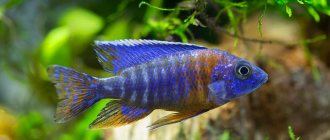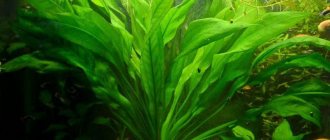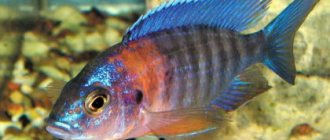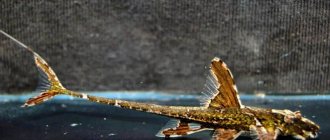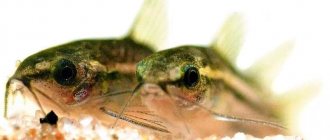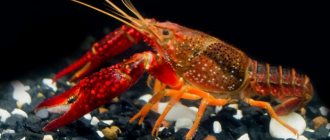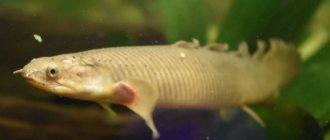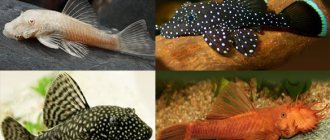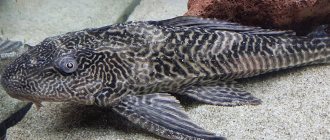Appearance Features
Appearance of Aulonocara:
- Size . These are quite large fish; the size of an adult can vary from 9 cm to 20 cm.
- Body . It is characterized by an elongated, elongated shape with a high ridge characteristic of representatives of this species.
- Head . It is distinguished by its large size and peculiar, somewhat angular shape. At the same time, small depressions are visible to the naked eye in the head area.
- Fins . The dorsal fin is the longest and most prominent. Anal - has a rounded shape and is yellowish-gray in color. Dark vertical stripes run along the fin.
- Color. The colors can be very diverse. There are fish with scales of pinkish, turquoise, black tones with a metallic sheen that shimmers in the light. The fins have the brightest color. In most cases, they are colored blue, light blue or gold. The anal fin is decorated with yellow or orange dots randomly located along its surface.
Females differ from males in their smaller size, rounded dorsal fin and muted color. The scales of females are painted in the same colors as those of males, but they seem more faded and do not have a characteristic tint. An interesting fact is that in males, the coloring is fully formed only when they reach 1.5-2 years.
The average lifespan of aulonocara ranges from 8 to 15 years.
The age of the fish depends on the specific subspecies, as well as care and conditions of detention.
Description
It grows up to 13 cm, although males can be larger, up to 15 cm and more. It takes up to two years for a male to fully develop his coloration. However, they live quite a long time, up to 10 years.
Males are mostly bright yellow, with blue stripes along the body and a blue patch on the gill cover that extends to the lips. The fish has a sloping head with large eyes. Females are light gray or silver, with vertical brown stripes.
Since the fish quite easily crosses with other cichlids, there are now a lot of different color variations.
Conditions of detention
In order for the fish to maintain its bright color, live long and be healthy, it is important to create comfortable living conditions for it:
- Choosing an aquarium . Large and active fish require a fairly large amount of free space. Therefore, the minimum volume of the tank, designed to contain 4-6 individuals, must be at least 200 liters. If there are a larger number of fish or proximity to other aquarium inhabitants, the volume of the artificial reservoir should be 400 liters or more.
- Water parameters : temperature - from +22 to +26°C; hardness - from 10 to 77 dGh; acidity - from 15 to 25 units.
- Filtration must be powerful and constant. Aulonocara is sensitive to indicators of the chemical qualities of the aquatic environment, so it is important to avoid increasing ammonia levels and silting of the soil.
- Aeration is necessary for these fish, which require increased amounts of oxygen.
- Vegetation . In the natural environment, aulonocara lives in reservoirs where there are no green spaces. Therefore, the presence of vegetation in an artificial reservoir is also not necessary. If you want to use aquatic and surface crops to decorate your aquarium, it is important to choose plants with a strong root system that fish cannot damage.
- Lighting . The best option would be moderate and diffuse lighting, which will also highlight the natural beauty of these fish.
- Decorating an aquarium . When creating an aquarium design, you need to take care of the presence of secluded corners in it, which can be decorative castles, caves and grottoes, and various driftwood. However, experts do not advise overusing decorative elements, since aulonocaras require a lot of space to move freely in the aquatic environment.
- The soil . It is recommended to give preference to sandy soil.
- Replacing water . Aulonocaras need clean water. Therefore, the fluid in the aquarium must be replaced at least once a week by 25% of the total volume of water in the tank.
Caring for aulonocara is simple. The main thing is to take care of a spacious aquarium and keep it clean.
Spreading
Aulonocar's habitat is Lake Nyasa (also called Malawi, as is the coastal state that lies along most of the coastline).
It is the third largest among the largest lakes in Africa. The most remarkable thing is the living world.
The waters are home to several hundred endemic species that are found nowhere else on the globe. 90% of all fish wealth is occupied by cichlids.
Aulonocaras belong to the coastal species. They live within 100 m from the shore at a depth of 5 to 30 m. The environment is a sandy or rocky bottom and a small number of aquatic plants.
Like other cichlids, aulonocara are predators. Pelagic species live in the water column, where they hunt invertebrates. Bottom-dwelling species constantly excavate sand and scour the bottom in search of benthos—fauna that lives near the bottom, buried in the sand or hidden between rocks.
Compatibility with other types
Aulonocaras have a calm and peaceful disposition, and therefore are compatible with most aquarium inhabitants.
Manifestations of aggression are possible only during the breeding season, but this problem can be solved by temporarily moving the fish to a separate spawning tank.
Excellent neighbors for Aulonocara will be:
- cichlids;
- blue dolphin;
- hummingbird;
- labidochromis yellow;
- aki blue;
- Copadichromis kadango.
It is not suitable to keep the peace-loving aulonocara in the same body of water with predatory, aggressive, overly large fish, such as:
- Haplochromis cornflower;
- some aggressive cichlid species;
- piranha;
- angelfish.
Also, you should not house aulonocara with overly active fish, since they are quite phlegmatic and periodically need peace and solitude.
Neighborhood
Aulonocaras have a rather peaceful character. However, serious competition occurs among males of the same species, when fish can fight to defend their territory.
If the aquarium is large, then African peaceful cichlids of other genera can be added to it - neutrality will be maintained towards them. Get along well with cichlids:
chain catfish
armored catfish
Although both of them like to hunt near the bottom, their activity does not coincide at the time of day, as a result of which they do not conflict with each other.
Breeding and reproduction
Aulonocara reproduce well naturally, even in an artificial reservoir. Moreover, this process does not even require special intervention from the aquarist. However, if you want to be guaranteed to get successful offspring, you should take care of creating optimal conditions for spawning.
Preparing for spawning . The size of the spawning tank should be about 200 liters per pair. It is imperative to decorate the tank with places for shelter and laying eggs. Grottoes, caves, crevices, and ceramic houses are perfect for these purposes.
A slight increase in temperature (up to +30°C) will stimulate and speed up the spawning process.
You can determine the readiness of fish to reproduce by observing your pets. During the mating season, males begin to show special activity, and the females' abdomen becomes rounded and increases in size.
Spawning . During spawning, males prepare places for laying eggs by making small holes in the sandy soil. After this, the mating dance itself begins, as a result of which the female lays from 15 to 80 eggs. Immediately after this process is completed, the female places the eggs and milt of the male in the oral cavity.
A unique feature of these fish is that the process of fertilization occurs in the mouth of the female. For females this is a very difficult period, because for 2 weeks during the formation of fry they have to refuse food.
Caring for offspring . The fry are born quite large and have an increased appetite. “Live dust”, brine shrimp, cyclops, and specialized food for fry are perfect for feeding babies. In the first months of life, when faced with potential danger, babies seek shelter in the mother’s mouth, from which they were born.
It is recommended to move the male to a common reservoir immediately after spawning, and the female after a month. Although some experts and experienced aquarists recommend doing this immediately after the fry appear. The fact is that, although aulonocaras are not prone to cannibalism, a female can accidentally swallow a baby trying to find shelter in her oral cavity.
Babies develop quickly and soon become completely independent. After a few months, they can safely be moved to a common artificial reservoir, with the exception of aquariums where predators live.
Habitat in nature
Aulonocara Bensch was first described in 1985. It is named baenschi in honor of Dr. Ulrich Bensch, founder of Tetra.
Endemic to Lake Malawi, they are found near Maleri Island, Chipoka, Nkohomo Reef near Benga. There are a total of 23 species of Aulonocara, although there are many subspecies.
It lives at a depth of 4-6 meters, but is also found at greater depths, often 10-16 meters. They can live both in caves and form large flocks. As a rule, each male has his own territory and shelter, and females form flocks.
They feed on various insects, which they search for and dig in the sandy bottom. To search for food, they have developed special sensitive pores on their jaws. They serve as a kind of sonar, helping to determine the noise from the entrenched larva.
As soon as the victim is discovered, she grabs it along with the sand. The sand is then spat out through the gills and the insect remains in the mouth.
Possible diseases
Aulonocaras have innate good health and strong immunity. However, if the conditions of detention are violated, and most importantly, if the water environment is polluted, there is a high probability of developing infectious diseases that require drug treatment prescribed by a veterinarian.
Aulonocara is a charming ornamental fish that attracts aquarists not only with its beauty, but also with its interesting habits, peaceful character, good compatibility with other inhabitants of the aquatic world and unpretentiousness in maintenance. Also, the fish are perfect even for beginner aquarists. A little attention, and these wonderful creatures will delight the eye for at least 8 years.
What to feed
The food for fish in their natural habitat is food of animal origin, and plant food takes up only 20% of their diet. With the help of sensitive areas on their heads, aulonocaras are able to detect the slightest vibrations of invertebrates in the soil, immediately attacking their prey.
Find out how to feed your fish with rotifers, ciliates, cyclops, daphnia, gammarus and dry food.
For varieties kept in an aquarium, food consists of frozen and live food in the form of small insect larvae, as well as special flakes that are often used for aquarium fish. Aulonocars are fed in small portions, once a day. Eating more frequently can cause obesity.
Aulonocara photo
Diseases
"Malawi bloat" is a common disease for aulonocaras, especially if they are fed poor quality food. The disease manifests itself as a bloated abdomen, the fish sinks to the bottom and does not swim. In this case, you need to reconsider the diet of the individuals.
Cichlazomas are susceptible to other common diseases, especially if the water is dirty, of poor quality and oxygenation. For example, white spot disease, which appears as crusts all over the body. To eliminate the disease, change 30% of the water and increase its temperature to 30℃ for 3 days.
